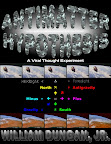1. Symmetrical forces.
2. A linear, zero centered coordinate system.
3. A scalable cellular mechanism for growth and propagation.
Identifying the excommunicated antigravity component was a consequence of the first and second premises. Assuming that antimatter possesses the antigravity property led to the identification, explanation, and demystification of the AMMO phenomenon.
So in essence, the premises provided a framework for identifying supporting evidence. Antigravity also solved the problem of how to fragment a black hole during cellular division, the sought after cosmic level mechanism of premise three. In hindsight, fragmenting black holes proved an invalid hypothesis. The last key piece of the puzzle fell into place when I examined an annotated Hubble Space Telescope image. Circles identified globular clusters surrounding an elliptical galaxy, which I recognized as a baby picture.

The date was Thursday, 29 May 2008. On Thursday, 5 June 2008, feeling confidence in the model and wanting to be comprehensive I tackled the formation of the enigmatic barred spiral galaxies. On Sunday, 15 June 2008 I realized antiparticle accretion disks act like gauntlets that produce relativistic jets. On Tuesday, 1 July 2008 I recognized spiral galaxy rim dust around elliptical galaxies, and realized a continuum of galaxy evolution as a consequence of inside-out galaxy formation.









No comments:
Post a Comment